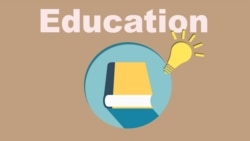It is never too late to ask for help. This advice can be useful for anyone in their day-to-day life.
It can also be important for someone hoping to get a college education one day.
Seeking admission to a college or university can be a complex process. There are so many things to consider. Some of the decisions you make can affect the rest of your life.
In the United States, most college applicants are high school students. Many are 17 or 18 years old. One might ask how anyone at that age could know exactly the kind of field they want to work in for the rest of their lives? Do they even want to work in the field they plan on studying?
So how do young people begin to make the first big step when applying for college?
Charlie Leizear of Occidental College says his first suggestion to students is to look for help anywhere they can find it. Leizear is the director of first-year admission at Occidental, a private liberal arts college in Los Angeles, California.
Leizear says there is a lot of information available to students about how to both choose a college and apply for admission. For one thing, he tells students to think about using their personal connections. If friends or family members have attended a college, they can be great people to ask about their experiences, he notes.
Also, most high schools in the United States and many other countries employ guidance counselors for this exact purpose. A big part of the job of a counselor is asking students what they want to do after high school. They ask these questions to help students decide if college is right for them, as well as identify what a student might want to study. Then counselors often help students find schools that might meet their needs and help them prepare application materials.
But Leizear admits that in many countries, higher education is not a possibility for most people. So some students may not know anyone who can answer their questions about college. This is especially true if the person is hoping to continue their education overseas. Also, high schools in many countries may not have guidance counselors. So where do students at these schools turn for help?
One resource Leizear suggests is Education USA, a program supported by the U.S. Department of State. This program has offices in more than 170 countries. Education USA has offices in U.S. embassies around the world. Other offices are connected with local non-profit organizations, or even at universities.
Education USA offers non-U.S. citizens advice and information about American colleges and universities. For example, most schools require students to take some form of standardized test. This test shows a student’s level of academic performance. Also, in the case of international students, it shows their English ability level. Education USA explains to students in foreign countries how and where they can take standardized tests.
The program also helps international students apply for visas so they can live, study and possibly work in the United States. And, perhaps most importantly, Education USA helps students find ways to pay for their education.
Leizear says paying for higher education can be the biggest barrier to college students, both in the United States and overseas. The College Board is a non-profit organization working to expand access to higher education. It reported that the cost of attending four-year colleges reached record high levels in the 2016 to 2017 school year.
Most U.S. colleges and universities offer students some form of financial assistance. But Leizear notes that during the economic recession of 2008, many schools faced financial difficulties. American stock shares and other investments shrank in value, so families had less money available set aside for education. Most of the aid schools had to offer went to Americans, not international students.
Many schools began requiring international students to pay the full price as a way of balancing the cost of supporting domestic students, Leizear notes. And some schools increased the number of students from wealthier nations they admitted since these families could bear that cost.
However, Leizear adds, as the economy recovered, colleges and universities began to change their financial aid policies. He says some schools continue to spend a lot on research or athletics programs. Yet many schools, like small liberal arts colleges, for example, see international students as valuable because of their skills and the activities they are involved in. And these schools have begun to offer such students large amounts of aid to become more appealing.
“It has taken some time for a lot of colleges and universities to look at international students beyond as just the bottom line, to look at international students as actually contributors to [their] communities,” Leizear told VOA on Skype.
He says the Internet is a great resource for identifying such schools. He suggests looking for lists of colleges and universities with financial aid for international students. For example, every year two independent college counselors, Jennie Kent and Jeff Levy, publish one such list that is freely available.
Finally, once a student has chosen the school he or she wants to attend, Leizear says there is still one more resource available. That is other international students. If an applicant calls a university’s international student office, it will often connect the applicant with a current student from their part of the world.
“Current students are often more than [happy] to tell [future students] about their application process and can be great resources without charging fees,” Leizear said. “And I think that’s where a lot of students find great value, … in getting the real story.”
Leizear warns college applicants against using services that ask for money and offer guaranteed acceptance into top schools as a resource. Often these services cannot actually follow through on their promises.
I’m Pete Musto. And I’m Dorothy Gundy.
Pete Musto reported this for Learning English. George Grow was the editor.
We want to hear from you. What other helpful resources do you know of for finding and applying to colleges, either in your country or the United States? Write to us in the Comments Section or on our Facebook page.
_____________________________________________________________
Words in This Story
admission – n. the act or process of accepting someone as a student at a school
applicant(s) – n. someone who formally asks for something, such as a job or admission to a college
liberal arts – n. areas of study, such as history, language, and literature, that are intended to give you general knowledge rather than to develop specific skills needed for a profession
guidance counselor(s) – n. a person who gives help and advice to students about educational and personal decisions
resource – n. a place or thing that provides something useful
standardized test – n. any form of test that requires all test takers to answer the same questions, or a selection of questions from common bank of questions, in the same way, and that is scored in a consistent manner
academic – adj. of or relating to schools and education
access – n. a way of being able to use or get something
financial – adj. relating to money
bottom line – idm. a company, school or organization's profits or losses
contributor(s) – n. someone who gives something, such as money, goods, or time, to help a person, group, cause, or organization











